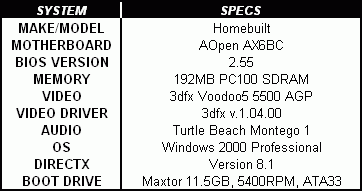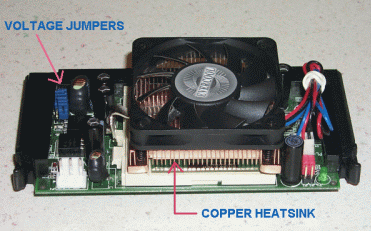| A BIT OF BACKGROUND.... |
|
With the apparent growing popularity of PowerLeap's iP3/T adapter as a viable CPU upgrade route for older BX systems, the question inevitably arises, "Can you overclock one of these things??" Up until recently, the answer was basically "not really" because of the lack of a way to boost the core voltage to the processor when using the iP3/T. Since any really significant boost in front-side bus (FSB) speed generally requires an increase in processor voltage to enable stable operation, this lack of a core voltage adjustment was pretty much a "show-stopper" for the overclocking enthusiast. But no more! The "rev.2" iP3/T adapter appeared about a month ago (see photo at right), and now incorporates voltage adjustment jumpers that allow the iP3/T to boost the processor voltage as high as the 1.80 - 1.825v range. At the same time, the cooling capabilities of the iP3/T have been significantly improved with the addition of a low-profile Evercool fan that features a copper heatsink to more efficiently disperse processor heat. All that bodes well for overclockability.
Of course, realizing that potential depends heavily upon the system motherboard that is used. For many owners of name-brand PCs, overclocking is simply not possible, because of the lack of any FSB speed adjustment on the motherboard. My Dell Dimension XPS-R is a perfect example of this. Top speed for this mobo is 100MHz....period. But there are many, many systems out there using retail motherboards that offer excellent built-in overclocking support. And many of these allow FSB adjustment through the system BIOS, rather than the older and less convenient method of setting jumpers on the motherboard.
As it happens, the machine I'm running as a personal web server falls squarely into this category. It's built around an AOpen AX6BC motherboard, vintage mid-'99 (see system specs below). The "chipset features" section of the BIOS offers a range of FSB settings between 66MHz and 150MHz, with several of them falling into the range of interest between 100 and 133MHz. So with the processor rig and the motherboard set up for overclocking, the only real question was if the rest of the system could take it or not. But I had run the system briefly at 133MHz with a Tualatin PIII-S (that's another story) and not seen any instability, so the prognosis was good.
| BENCHMARKING SCHEME: |

To quantify the impact of overclocking on the performance of the Tualatin Celeron, the following set of benchmarks were employed:
- SiSoft Sandra 2001 CPU & Multimedia Benchmarks
- MadOnion PCMark 2002 CPU Benchmark (composite result of 6 tests)
- MadOnion 3DMark 2001SE DirectX Video Benchmark (default test - 1024x768x32)
- GL Excess v.1.1 OpenGL Video Benchmark (all tests; run @ 640x480x16 & 1024x768x32)
- Quake 3 Arena "Demo002" Timedemo (640x480x16 & 1024x768x32)
For all tests, vsync was disabled and antialiasing was turned off.
So, with the hardware squared away and the testing scheme defined, it was time to start benchmarking....

